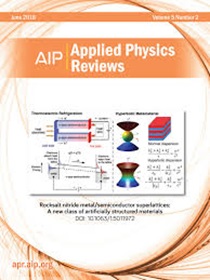Cobalt ferrite nanoparticles: The physics, synthesis, properties, and applications
IF 11.9
1区 物理与天体物理
Q1 PHYSICS, APPLIED
引用次数: 0
Abstract
Spinel cobalt ferrite (CoFe2O4, CFO) nanoparticles (NPs) are a major focus of fundamental science and technological innovation due to their distinctive mix of magnetic, electrical, and chemical characteristics. CFO NPs have outstanding chemical stability, modest saturation magnetism (∼80 emu/g), a high Curie temperature (∼793 K), and significant magnetocrystalline anisotropy. These characteristics, further improved by cation substitution and surface functionalization, enable a wide range of applications. This review provides a comprehensive analysis of CFO NPs, covering their synthesis methods, physicochemical characterization, surface modifications, and diverse applications. We compare the environmental impact, scalability, yield, and particle size control of a variety of synthesis techniques, including co-precipitation, hydrothermal, sol-gel route, combustion method, microemulsion, thermal decomposition, electrochemical synthesis, polyol method, and green synthesis methods. The sustainable alternative of green synthesis, which employs plant- and microbe-mediated biosynthesis, is becoming increasingly important in the biomedical and environmental sectors. Furthermore, we explore advanced surface functionalization techniques that employ monomeric, inorganic, and polymeric stabilizers to improve the biocompatibility and stability of CFO NPs. The effects of cation substitution (such as transition metals and rare-earth dopants) on the physicochemical and magnetic properties of CFO NPs are examined in detail, addressing challenges like cost and stability in real-world applications. Moreover, the present review provides a detailed discussion correlating structural, morphological, magnetic, dielectric, optical, and electrical properties of CFO with synthesis methods and modifications. The traditional energy storage and conversion applications of CFO are comprehensively discussed. Additionally, the review highlights magnetic applications, biomedical applications (e.g., MRI contrast agents, magnetic hyperthermia, and biosensors), the role of CFO in electronics and optoelectronics, purification and catalysis applications, as well as advances in electromagnetic technologies. Emerging applications, including their roles in quantum computing, nanorobotics, tissue engineering, and bioimaging, are also discussed, emphasizing the cutting-edge potential of CFO NPs in multifunctional technologies. The objective of this review is to critically evaluate recent advancements, challenges, and future research directions to bridge the divide in understanding CFO NPs. This systematic evaluation establishes a strong foundation for researchers, allowing them to investigate novel applications of CFO NPs in both current and emerging technological domains.钴铁氧体纳米颗粒:物理、合成、性能和应用
尖晶石钴铁氧体(CoFe2O4, CFO)纳米颗粒(NPs)由于其独特的磁性、电学和化学混合特性而成为基础科学和技术创新的主要焦点。CFO NPs具有优异的化学稳定性、适度的饱和磁性(~ 80 emu/g)、高居里温度(~ 793 K)和显著的磁晶各向异性。这些特性,通过阳离子取代和表面功能化进一步改善,使其具有广泛的应用。本文对CFO NPs的合成方法、理化性质、表面改性及其应用进行了综述。我们比较了各种合成技术的环境影响、可扩展性、产率和粒度控制,包括共沉淀法、水热法、溶胶-凝胶法、燃烧法、微乳液法、热分解法、电化学合成法、多元醇法和绿色合成法。绿色合成的可持续替代品,采用植物和微生物介导的生物合成,在生物医学和环境部门变得越来越重要。此外,我们探索了先进的表面功能化技术,使用单体、无机和聚合物稳定剂来提高CFO NPs的生物相容性和稳定性。详细研究了阳离子取代(如过渡金属和稀土掺杂剂)对CFO NPs的物理化学和磁性能的影响,解决了实际应用中的成本和稳定性等挑战。此外,本文还详细讨论了CFO的结构、形态、磁、介电、光学和电学性质与合成方法和改性的关系。对CFO的传统储能和转换应用进行了全面的讨论。此外,该综述还强调了磁性应用、生物医学应用(例如,MRI造影剂、磁热疗和生物传感器)、CFO在电子和光电子、净化和催化应用中的作用,以及电磁技术的进步。新兴应用,包括它们在量子计算、纳米机器人、组织工程和生物成像中的作用,也进行了讨论,强调CFO NPs在多功能技术中的前沿潜力。本综述的目的是批判性地评估最近的进展、挑战和未来的研究方向,以弥合对CFO NPs理解的分歧。这种系统的评估为研究人员奠定了坚实的基础,使他们能够研究CFO NPs在当前和新兴技术领域的新应用。
本文章由计算机程序翻译,如有差异,请以英文原文为准。
求助全文
约1分钟内获得全文
求助全文
来源期刊

Applied physics reviews
PHYSICS, APPLIED-
CiteScore
22.50
自引率
2.00%
发文量
113
审稿时长
2 months
期刊介绍:
Applied Physics Reviews (APR) is a journal featuring articles on critical topics in experimental or theoretical research in applied physics and applications of physics to other scientific and engineering branches. The publication includes two main types of articles:
Original Research: These articles report on high-quality, novel research studies that are of significant interest to the applied physics community.
Reviews: Review articles in APR can either be authoritative and comprehensive assessments of established areas of applied physics or short, timely reviews of recent advances in established fields or emerging areas of applied physics.
 求助内容:
求助内容: 应助结果提醒方式:
应助结果提醒方式:


